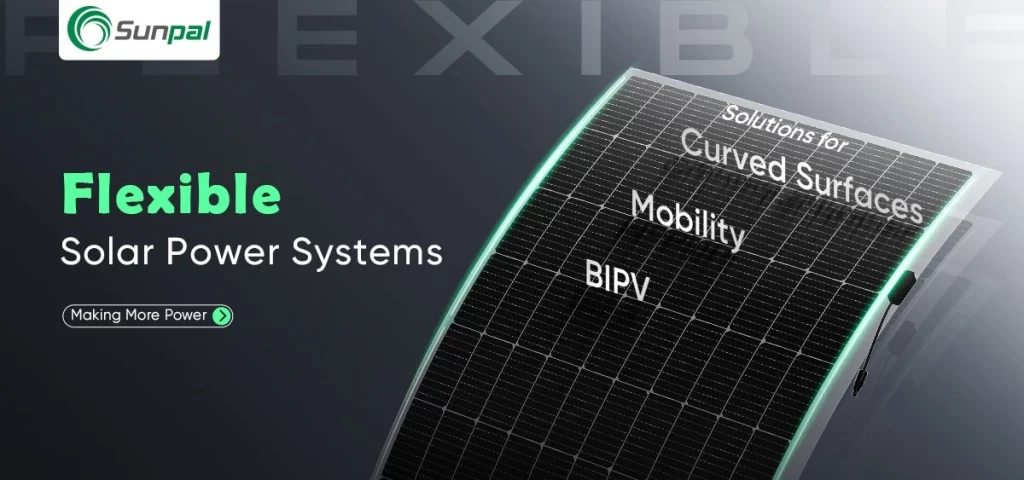
In the world of solar innovation, not every panel fits neatly on a pitched roof or utility-scale array. Enter flexible solar power systems—the agile, lightweight, and adaptable alternative to traditional silicon-based modules. These next-gen photovoltaic (PV) technologies are turning impossible spaces into powerful energy hubs, pushing solar into sectors it could never reach before.
As solar adoption accelerates across industries, so does the demand for customized solar solutions, and flexible solar is emerging as the answer for edge-case installations—from curved surfaces and portable gear to disaster zones and space-constrained cities.
Breaking the Mold: What Sets Flexible Solar Apart
Traditional panels are efficient workhorses, but their rigid structure, heavy glass casing, and size constraints limit where and how they can be installed. Flexible solar panels, on the other hand, are:
- Made from thin-film materials like CIGS (copper indium gallium selenide), organic PV, or flexible silicon.
- Ultra-lightweight, often up to 80% lighter than crystalline panels.
- Bendable up to 30° or more, allowing curvature and mobility.
Chart 1: Traditional vs. Flexible Solar Panel Comparison

Unstoppable in Unusual Places: Where Traditional Panels Fall Short
1. Curved Architecture & Futuristic Designs
Imagine a stadium with a domed roof or an art museum with flowing architecture. Rigid panels simply don't fit without expensive customization or visual compromise.
Flexible modules, by contrast, contour seamlessly onto:
- Dome-shaped buildings
- Metal silos and storage tanks
- Inflatable or tension fabric structures
They empower architects and engineers to think beyond flat surfaces without sacrificing solar performance.
2. Mobility: Solar That Moves With You
RVs, food trucks, yachts, and even cargo containers are joining the clean energy revolution thanks to flexible solar kits. Designed for mobility, they:
- Attach easily with adhesives or magnets
- Charge onboard batteries or hybrid inverters
- Power appliances in off-grid or remote environments
This opens opportunities in transportation, agriculture, and tourism, especially in areas lacking grid access.
3. Building-Integrated Solar (BIPV)
Flexible solar panels make energy-producing surfaces possible, turning ordinary elements like roofing membranes, wall panels, or canopies into active solar harvesters. This is especially relevant in:
- Urban retrofits, where adding bulky panels isn't feasible
- Commercial buildings, where energy and aesthetics must align
- LEED-certified construction, where BIPV improves sustainability scores
Sunpal is investing in scalable BIPV solutions for residential and commercial buildings worldwide, combining form and function to meet evolving energy codes.
Chart 2: Global Market Forecast – Flexible Solar vs. Rigid Panels (2024–2030)
This chart visualizes the rapid growth expected in flexible solar technologies over the next several years, showing how flexible solar market share is poised to increase.

- CAGR (Compound Annual Growth Rate) for flexible solar is 18.7% from 2024–2030, signifying a strong upward trajectory.
- Flexible solar technology is becoming an increasingly viable solution for niche applications and is expected to continue gaining market share.
Real-World Success: Flexible Solar in Action
Emergency Response & Remote Deployment
NGOs and military operations increasingly turn to rollable or foldable solar mats for quick, rugged deployment in:
- Disaster zones
- Conflict areas
- Remote telecom towers or monitoring stations
Sunpal's modular off-grid solar kits, soon to include flexible modules, aim to support rapid deployment for crisis response and field operations.
Wearables and Micro Applications
While not yet mass market, wearable solar is becoming a reality. Flexible PV is being embedded into:
- Backpacks for charging phones
- Smart clothing for athletes or soldiers
- Tents and fabric shelters for extended off-grid use
This micro-generation frontier offers long-term potential for personal electronics, remote IoT sensors, and smart infrastructure.
Beyond Standard: Sunpal's Custom Approach to Solar Innovation
At Sunpal, we recognize that one size doesn't fit all in solar. That's why our engineering and R&D teams are actively developing flexible solar systems tailored to niche markets and new use cases.
Key advantages we bring to clients:
- Modular system design for flexible PV integration
- Hybrid solutions combining traditional and flexible panels
- Consultation and customization for BIPV and mobile applications
Our global presence and end-to-end manufacturing allow us to stay ahead of emerging trends, delivering innovation that fits—even when the space doesn't.
Chart 3: Flexible Solar Applications by Industry (Projected Growth by 2028)
This chart highlights the key industries adopting flexible solar technologies and their projected growth by 2028.

A Flexible Future for Solar Innovation
Flexible solar power systems aren't here to replace traditional panels—they're here to expand the solar horizon. As more industries adopt clean energy mandates and pursue net-zero targets, adaptable, mobile, and integrated PV solutions will be essential.
With ongoing R&D, performance improvements, and broader commercial availability, flexible solar is set to become a mainstream clean energy option by the end of the decade.
Interested in flexible solar for your next project?
Sunpal offers consultation, customization, and full system design for clients looking to go beyond traditional PV solutions. Reach out today and explore how flexibility fuels the future.
